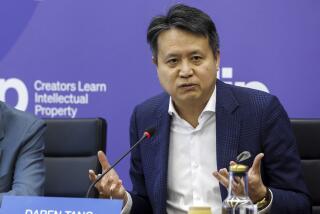U.S. lead in science research and development narrows
- Share via
WASHINGTON – The United States could be losing its edge in science and technology as emerging nations rapidly increase their investment in research and development, according to new indicators released Thursday by the National Science Board.
Although the United States outspends all other nations at least 2 to 1, its share of global spending on R&D has fallen in the last decade. With China at the lead, Asia’s major economies together now account for a larger share of scientific investment, the indicators show. Other nations with significant R&D growth include South Korea, Brazil and India.
This trend can be partially attributed to nations investing heavily in universities to educate their labor forces and drive research, NSB Vice Chairman Kelvin Droegemeier said during a conference call.
“Now we see other nations moving rapidly and very strategically to bolster their own competitiveness,” he said. “American universities, without question, remain the destination of choice for scientists around the world but even our universities now face great competition from abroad.”
Droegemeier, also the University of Oklahoma’s vice president for research, stressed the need to address pressures on enrollment, funding and tuition.
But scientific research is not a “zero-sum game,” NSB scientists repeatedly said during Thursday’s call, noting that increased R&D spending worldwide can be a positive investment for all nations.
“There are obviously examples that you can look at where development in one country – some innovation – resulted in global and worldwide impacts of benefit to all,” said Ray Bowen, who heads the board’s Committee on Science and Engineering Indicators.
As the policymaking wing for the National Science Foundation, the NSB is legally required to compile science-related indicators every two years. In addition to R&D, this year’s 600-page report offers insight into the place of science and technology in education, the labor force and public opinion.
While the indicators show U.S. predominance waning, the nation still leads in some areas, including total spending on R&D, the number of high-quality research publications and export income from intellectual property.
The board plans to issue at least one companion piece to Thursday’s report to provide further analysis of the data and trends, NSB Chairman Dan Arvizu said.
“What we want to come back to is that the science board advocates strong, sustained, predictable investments in R&D, and I think it’s up to us to make that compelling case as to why that’s important,” Arvizu said. “We think to a large degree that is maybe under-appreciated these days.”
Key takeaways from the indicators, in five charts:
1) Asia is up. Europe and North America are down.
Regional Share of Worldwide R&D Expenditures: 1996 vs. 2011
The past 15 years have seen a regional shift in R&D investment. The United States’ share of global R&D investment is currently 30%, a seven-point drop since 2001. During the same period, R&D funding in Asian countries – including China, India, Japan, Malaysia, Singapore, South Korea and Taiwan – jumped from 25% to 34%. China alone saw its share increase from 4% to 15%.
2) China is winning the R&D growth race.
Average Annual Growth in Domestic R&D Expenditures (2001–2011)
With an average annual growth rate of more than 20%, China far outpaces its competitors in how rapidly it has grown scientific investment in the past decade. South Korea is notable for its high R&D investment growth, but at just more than 10%, it hardly touches China’s lead.
3) U.S. and China are both behind in “R&D intensity.”
R&D Expenditures as a Share of Economic Output (1996–2011)
Although the U.S. and China spend the largest total amounts on R&D investment, the two countries lag far behind in spending as a share of GDP, described in the report as “R&D intensity.” The report found smaller countries such as Israel, South Korea and Sweden have a larger R&D-to-GDP spending ratio. The United States ranks 10th in R&D intensity, according to the NSB scientists on Thursday’s conference call.
4) China tripled its researchers since the mid–1990s.
Estimated Number of Researchers (1995–2011)
In addition to investing in R&D, countries such as China and South Korea are focused on creating a high-skilled workforce, the report found. Since the mid-1990s, China has tripled its workforce. Between 1995 and 2006, South Korea also saw a large increase, doubling its number of researchers.
5) In total R&D spending, no one beats the U.S.
Domestic R&D expenditures for selected countries (1996–2011)
The U.S. might be losing its predominance in R&D investment, but it is important to remember that everything is relative. The United States still devotes huge sums of money to R&D, outspending all other countries at least 2 to 1. Alone, the United States spent over $400 billion in 2011. China spent just over $200 billion.
SOURCE: National Science Board Science & Engineering Indicators 2014
Twitter: @danielrothberg
More to Read
Get the L.A. Times Politics newsletter
Deeply reported insights into legislation, politics and policy from Sacramento, Washington and beyond. In your inbox twice per week.
You may occasionally receive promotional content from the Los Angeles Times.









